The following is a slightly edited transcript of a lecture given at the Oxford C.S. Lewis Society, which was founded in 1982 to promote interest in and knowledge of the works of C.S. Lewis. Portions of this more expansive essay have been published elsewhere, including in the Winter 2016 issue of Providence’s print edition, which can be read on the website here.
Audio from LiVecche’s lecture is also available here:
I assume in this crowd it’s okay to begin a talk on Lewis in Middle Earth?
I do not slay man or beast needlessly, and not gladly even when it is needed… War must be, while we defend our lives against a destroyer who would devour all; but I do not love the bright sword for its sharpness, nor the arrow for its swiftness, nor the warrior for his glory. I love only that which they defend.
So says Faramir, Captain of Gondor, thereby intersecting the notion of love with the cataclysm of war; indeed, pressing the claim that war can be an expression of love. Everything that follows will follow from the fact that the Christian ethical life has as its central commitment the dominical command to love.
This love command is not an option. It’s an absolute mandate. But because of the conditions of this world and the human soul, it is not always clear precisely how it is we are to love our neighbor. For instance, how do we love one neighbor when he is unjustly kicking in the face of another neighbor—whom we are also called to love? If the first neighbor—let’s call him the enemy-neighbor—refuses to stop his kicking and our victim-neighbor is unable to defend himself, then we cannot love both neighbors in precisely the same way. But the question is never whether to love one or the other, but what does loving both, individually, look like now, in this moment?
C.S. Lewis, standing in an Augustinian stream, reveals the guidance found in the Greco-Roman and Judeo-Christian patrimony that has fortified Christian intelligence regarding the use of force since the beginnings of the church. Lewis provides guidance in how we are to love, in conflict situations, both our enemy-neighbor as well as our innocent neighbor. Just how war can be an expression of love for the assailed neighbor we are rescuing is self-evident. How it can also be an expression of love for the one from whom we are rescuing him is, perhaps, a bit less clear. But Lewis will show how it is possible even to love our enemies, even to love them to death. To make a start, let us travel now to from Middle Earth to Narnia (different zip code but similar climate).
In the dead of night, young Caspian, future king of Narnia, stands with his tutor Cornelius atop the central tower in the great castle at the center of the realm. They have come to witness the conjunction of two noble planets: Tarva, the Lord of Victory, and Alambil, the Lady of Peace. These celestial bodies will pass within one degree of each other. Such a meeting, Cornelius instructs his pupil, has not happened for two hundred years, and signals fortune for the sad land, which we soon learn manifests in Caspian’s commanding an insurrection of dwarves and talking beasts in The Great War of Deliverance that liberates Narnia from the usurping grip of his evil Uncle Miraz.
By some accounts, we have already gone way too far. The Narnian Chronicles “is one of the most ugly and poisonous things I’ve ever read. A sado-masochistic relish for violence permeates the whole cycle.” So asserts the author of the His Dark Materials trilogy, Phillip Pullman (known perhaps to some as He-Who-Must-Not-Be-Named). Quite similarly, another pair of literary critics charged that among the Narnian books’ offenses are the “glorification of conflict and retribution” and the “legitimizing of cruelty.”[1] Such critics might well have had Prince Caspian particularly in view. In this second book in the Chronicles (and it is the second book—we can be democratic about the sequence, I suppose, but God is watching and you will be judged) blood, battle, betrayal, maiming, and death feature frequently. Indeed, the High King Peter, just a schoolboy, is described in one instance as having felled an enemy by “slash[ing] his legs from under him and with the back-cut of the same stroke, wallop[ing] off his head.” It’s grim, to be sure. But to Pullman it’s much more: “Thehighest virtue—we have this on the authority of New Testament itself—is love, and yet you find not a trace of that in the [Narnia] books.”
Heartened as I’m sure Lewis would be by his atheist critic’s pontificating on the character of the Christian Bible, Pullman doesn’t have it quite right—love, that is. For Lewis, the Narnian stories are all about love—not about love despite the battles and wars, but about love that, because it is love, reveals itself in the rescue of the innocent, the defense of justice, and the punishment of evil even, in the last resort, by war and, most crucially, in the character of the warriors who wage those wars. To expound on this, let us now travel to yet another place.
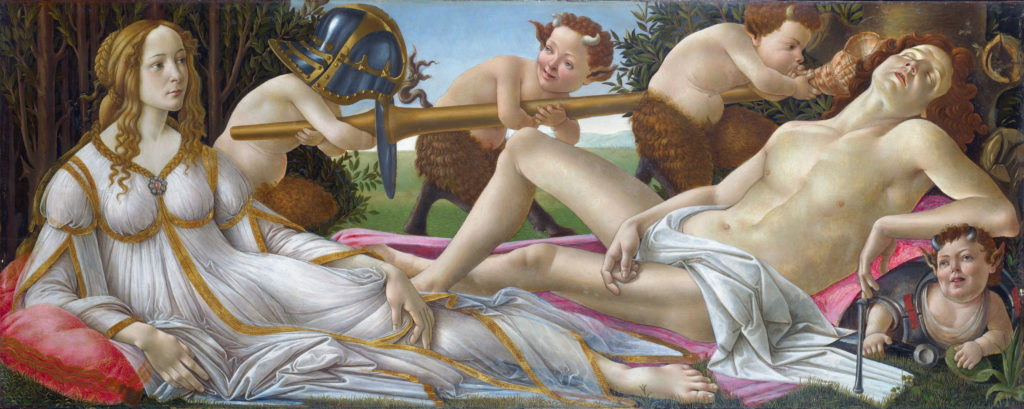
In room 58 of the Sainsbury Wing of the National Gallery in London resides the undercelebrated Venus and Mars by renaissance master Sandro Botticelli. The paintingportrays the post-coital deities reclining opposite one another in a little wood and surrounded by a small fold of rather frolicsome satyrs. If you look at any number of commentaries on the painting—including the National Gallery’s own website—you’ll note that the work is typically taken to symbolize the platitude that love conquers war. Admittedly, the immediate presentation seems to bear this out: Venus, goddess of love, is clothed and awake, watching Mars, the war god. Mars is naked and very much asleep, unarmed and unarmored—captive perhaps by the Venerian fetters of la petite mort—the little death, the post-orgasmic ebbing or weakening of consciousness that is likened to the loss of life. On the surface, Mars indeed seems overthrown.
However, initial appearances aside, prolonged consideration renders this interpretation unsatisfying. Our suspicions initially deepen upon learning that a facsimile of the Botticelli masterwork hung in Lewis’ Oxford rooms in Magdalen College.[2] Lewis was self-confessedly unenthusiastic about paintings in general,[3] as the apparently mostly unadorned walls in his office and home might testify,[4] and it can scarcely be believed that Lewis, unlikely to overlook simplistic aphorisms, would include among the few paintings for which he did care one bearing a theme so saccharine. Happily, there can be found within the Lewisian corpus promising explanatory keys. Two are particularly pertinent.
The first is found in a letter Lewis wrote in late autumn, 1925, to his friend the historian A.K. Hamilton Jenkin. “In a certain juncture of the planets,” Lewis mused, “each planet may play the others’ part.” Turning back to Botticelli, this suggestion has some purchase. Mars has lost much of the martial aspect. Dispossessed of his armor and his lance—euphemistically unmanned—he is defenseless as he slumbers almost fully exposed save for a strip of cloth draped with modest precision across his hips.
In contrast to Mars, Venus, however, appears to have taken up the martial character. She may not be merely watching Mars but watching over him as well: she has acquired her lover’s helm and lance, which thanks to the satyrs have now been visually repositioned so as to suggest she is wielding them. Truly, each does seem to now be playing the other’s part.
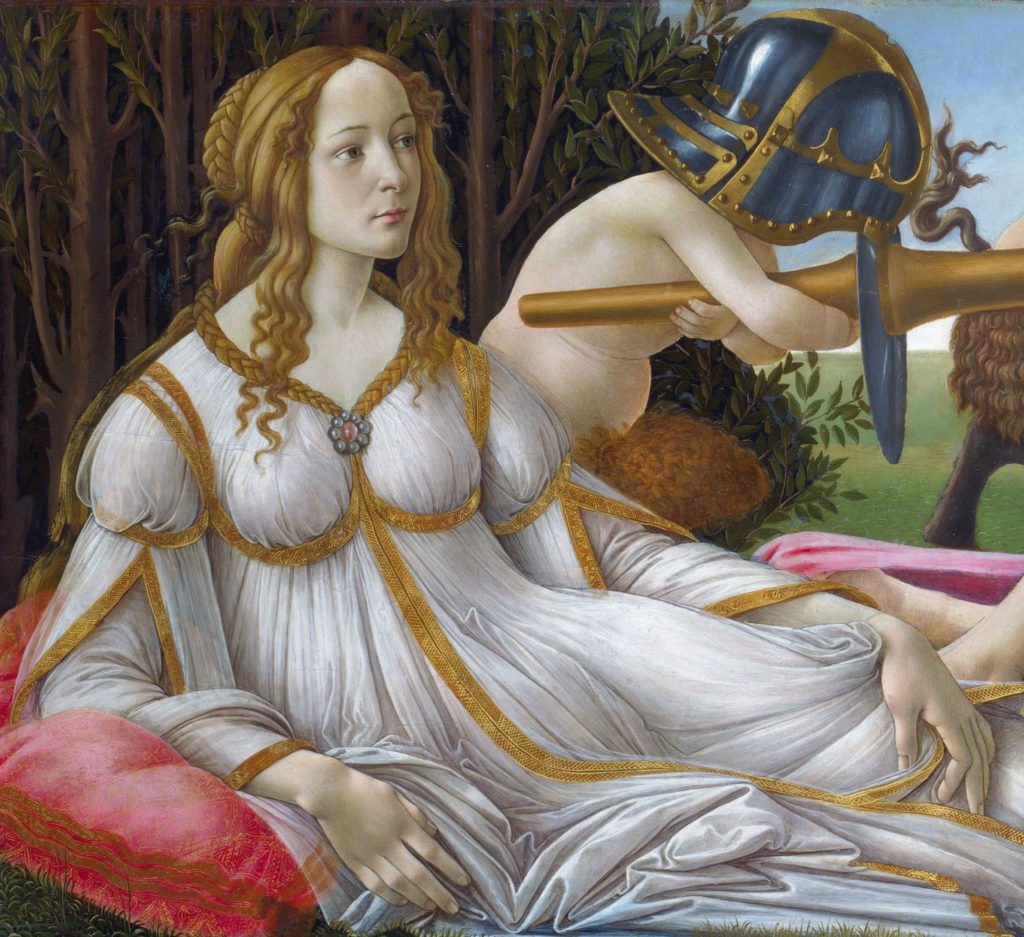
But, importantly, the reversal is incomplete. Venus is still Venus, evidenced not simply by the sated repose of her lover but by her own continued physical beauty—a beauty delicately eroticized by her diaphanous gown, which not only teasingly hints at the comely form beneath, but which she happens to be presently drawing up her leg. One can see the folds of garment just beginning to gather beneath her fingers as she pulls. Precisely what Venus has in mind is speculative, of course, but it might be suggested by the satyr who appears about to wake Mars with a conch shell blast in his ear. The fact of the garment drawing up her leg and Mars’ imminent rousing (not to say arousal) are surely connected. Mars, for his part, is still recognizably the war god: well-muscled, his strength remains at hand, however immediately latent—indeed, his very nakedness, while at one level suggesting vulnerability, was in the Renaissance imagination a sign that he was in total control even when most vulnerable.[5] It’s worth pointing out that the blowing of the conch shell plays into this idea. The ancient Romans believed the peaceful dormancy of the God of War could be interrupted by ritual incantation. As Roman warriors entered the battlefield, their warlord was to shout “Mars vigilia”—“Mars, awaken!” Thus stirred, the war god would lead the Romans to victory.
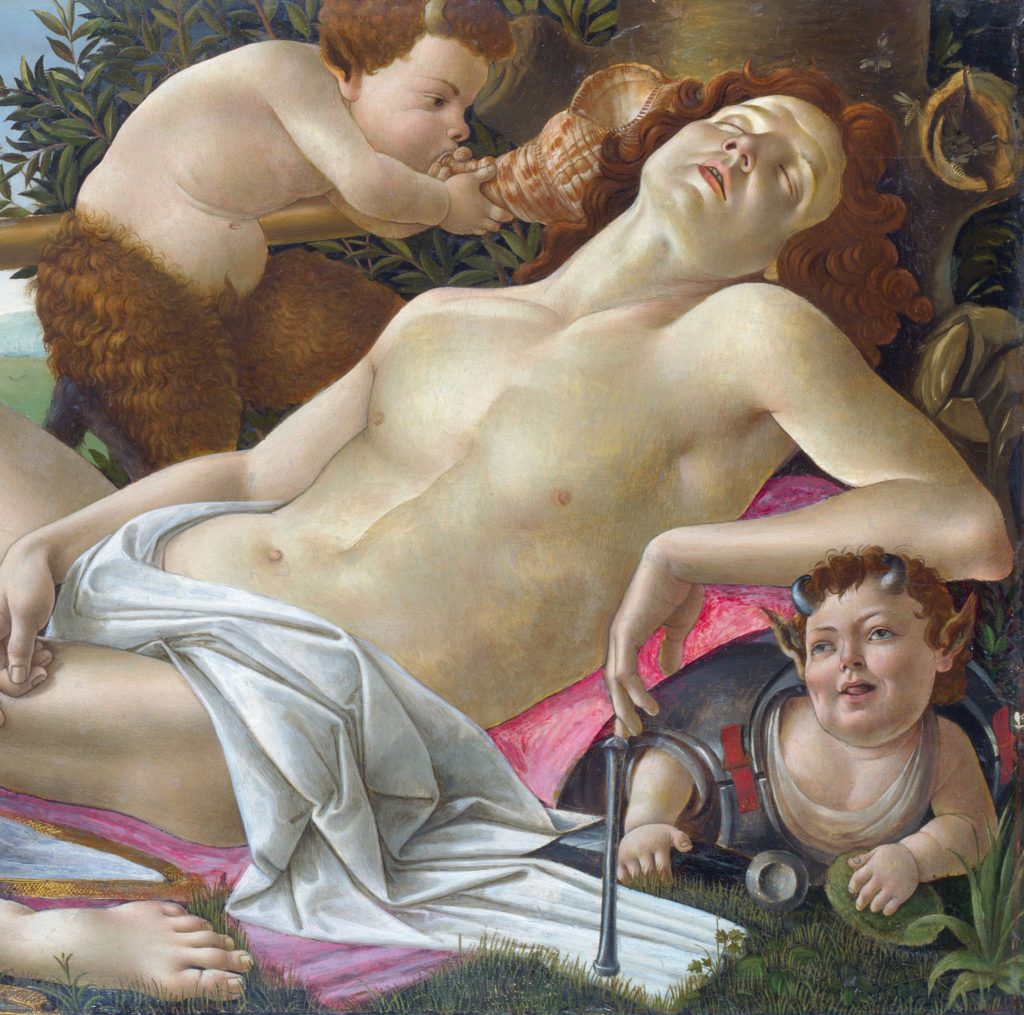
To account for Venus and Mars resilient self-possession, we now bring into play Lewis’ second explanatory key. In a critical analysis of The Faerie Queene, Lewis describes how Renaissance depictions of inverted relationships in images of cosmic order were meant to convey not a triumph of one over the other, but rather mutual reconciliation.[6] This idea is borne out in the name of Venus and Mars’ most noteworthy offspring, their daughter Concordia—the personification of harmony, unity, accord, peace. Venus and Mars—love and war—embrace and reform one another in mutual self-giving without either annihilating the other. Now this idea is something with which Lewis could truck.
It also alerts us to what Lewis might have been up to on that central tower in Narnia. While it is popularly assumed that Tarva and Alambil signify the Narnian version of Mars and Venus, this might not be so. In Planet Narnia: The Seven Heavens in the Imagination of C.S. Lewis, Michael Ward points out that on several occasions we are told the Narnian morning star is actually called Aravir, not Alambil. Instead, Ward posits, the conjunction that Caspian observes is meant to be the coming together of two aspects of the martial influence. “Mars is not only a fighting-machine,” Ward notes, “he has a more pacific, life-giving dimension too.” Mars was originally a spring-time god of vegetation and fertility. Under the name Mars Silvanus, his functions were rustic; he dwelled in forests and mountains and cared for cattle. His warrior dimensions, Mars Gradivus, came later, eventually superseding his less-belligerent roles. This double-nature is paralleled both in the Botticelli—by the presence of arms and armor as well as woodland satyrs and the lover’s arboreal nest—and in the architecture of the Narnian tower on which Caspian stands. Ward notes that Lewis describes the tower as having battlements on one side and on the other, un-embattled side, a direct view of the castle gardens.
In any case, whether through the influence of Venus or the two-aspects of his internal character, Lewis’ Mars—and the martial character he influences in others—is about much more than war and violence. For Lewis, the fullness of the martial character is best communicated by the chivalric idea of “the knight—the Christian in arms for the defence of a good cause,” which Lewis called “one of the great Christian ideas.” This chivalric ideal, in turn, is best understood through those words addressed to the dead Launcelot, the greatest of all the knights, in Malory’s Morte D’Arthur: “Thou wert the meekest man that ever ate in hall among ladies; and thou wert the sternest knight to thy mortal foe.” Lewis expounds:
The important thing about this ideal is…the double-demand it makes on human nature. The knight is a man of blood and iron, a man familiar with the sight of smashed faces and the ragged stumps of lopped-off limbs; he is also a demure, almost a maidenlike guest in hall, a gentle, modest, unobtrusive man. He is not a compromise or happy mean between ferocity and meekness; he is fierce to the nth and meek to the nth.[7]
We find presupposed in this what the late political theorist—and Narnia-friend—Jean Bethke Elshtain found presupposed in the Christian just war tradition. On this topic, Elshtain and Lewis both stood in the Augustinian stream of Christian realism. Among much else, the Augustinian realist does not judge the martial nature something to be overcome, recognizing instead that given the conditions of this world, martial power, including coercive justice, is a basic, even salutary, property of political life. However, because human beings are motivated both by love and kindness as well as selfishness and cruelty,[8] the use of force must be viewed with skepticism[9] and deployed within carefully prescribed constraints.
This recognition is exemplified in the Christian moral framework known as the just war tradition, which states that wars may be justly fought only when a sovereign authority—over whom there is no one greater charged with the care of the political community—determines, in the last resort and with the aim of peace, that discriminate and proportionate force is necessary to retribute a sufficiently grave evil, to take back what has wrongly been taken, or to protect the innocent. In such cases, and only such, war may be required to restore justice, order, and peace—political goods without which no other political good can long perdure. The just war framework provides a way of reflecting on the necessity and limits of force that accounts for, and subsequently seeks to reform, the presence in human beings of “two different states of nature: the state of integral nature and the state of fallen nature,”[10] alternatively cast as original innocence and original sin. These twin anthropological realities issue in two kinds of competing freedoms: cupiditas, which enshrines a form of self-love and tends toward the domination of others,[11] and caritas, an orientation to the good and love of the neighbor, including a recognition of one’s own interdependencies[12] and subsequent understanding that “dependence on others is not a diminution but an enrichment of self.”[13]
Insisting human beings are not limitlessly free,[14] Elshtain argued against overly voluntaristic construals[15] of freedom—essentially arbitrary willfulness refusing to recognize intrinsic constraints[16]—which, paired with cupiditas, fuels the estrangement, conflict, and tragedy that constantly feature in human relationships.[17] She supported instead the Augustinian notion of freedom as acts recognizing a limit undertaken in submission to something beyond the self[18]—namely, the character, requirements, and aspirations of divine love.
This then is the salient connection: Botticelli’s Venus and Mars supports an Augustinian reading in which love qualifies, but does not eradicate,war. This points, as Elshtain insists, to the existence—or possible existence—of a certain kind of self: that is, “one strong enough to resist the lure of seductive, violent enthusiasms; [and] one bounded by and laced through with a sense of responsibility and accountability.” This is to say that chivalry was always something more than literary artifact.
Writing at the beginning of the Second World War, Lewis found the chivalric ideal to be terribly relevant: “It may or may not be practicable—the Middle Ages notoriously failed to obey it—but it is certainly practical; practical as the fact that men in a desert must find water or die.” The key was in remembering the knight “is a work not of nature but of art; of that art which has human beings, instead of canvas or marble, for its medium.” Chivalry attempted to bring together two things that since the fall of humanity have no natural tendency to gravitate toward one another: it teaches “humility and forbearance to the great warrior because everyone knew by experience how much he usually needed the lesson,” and it demands “valor of the urbane and modest man because everyone knew that he was as likely as not to be a milksop.”[19]
The danger, as Lewis saw it, was that if we cannot produce Launcelots, humanity falls into two sections: those who can deal in blood and iron but know nothing about mercy and kill men as they cry for quarter, and “those who are ‘meek in hall’ but useless in battle.” That’s the hopeless choice: either Achilles, who at his worst captured and killed men at his leisure; or Caspar Milquetoast—that H.T. Webster cartoon anti-hero, a coward who stood up to nothing.
Against both Achilles and Milquetoast, Lewis gives us such figures as Reepicheep—the high mouse of Narnia, arguably the most courageous, most devout follower of Aslan in all the Narnian tales. It’s Reepicheep who most plainly displays this marbling of ferocity and meekness that Lewis calls for in the knight. Reep constantly champions the courageous defense of the innocent and yet is most eager to journey to Aslan’s country where he will no longer need to bear arms. Recall how just before he sails alone into the “utter east” he bids farewell to Edmund and Lucy and gives up his sword—in a most Arthurian of ways. The only time he ever dispensed with his weapon is when he knew he would need it no longer. One imagines him in Aslan’s country with a plowshare.
It is probably time here for a philological refresher. The term “meek” is rather out-of-favor nowadays. “Meek” sounds “weak,” hardly a quality worth cultivating. Jesus of course paints a similarly perplexing image when he assures us in the Sermon on the Mount that the meek are especially blessed. But, modern misunderstanding notwithstanding, there is nothing weak or spineless about the meek. Indeed, the term from which both the chivalric ideal and scripture draw is praus, a term used to describe a warhorse trained for battle—emphasizing power disciplined, or ferocity under restraint. Warhorses could propel their 2,000 pounds up to 35 miles-per-hour, smashing through and scattering enemy formations; they could instantly respond, in the din of battle, to the sudden commands of the one who held their reins; and they could bite and kick and strike and become, themselves, deadly weapons. There was nothing weak about them. In this sense, meek is the best summary-word for the way in which love qualifies (but does not abolish) the martial spirit and its lethal expression.
But why does love not abolish the martial spirit? How can love and war ever, really, be compatible? As I projected earlier, while it is obvious how war can be waged out of love in defense of one’s threatened neighbor, it remains that the one who is doing the threatening is a neighbor as well. How can we both love our enemy-neighbor and kill him?
In The Problem of Pain, Lewis avers that when people think about love they very often confuse it with kindness—the “desire to see others…happy; not happy in this way or in that, but just happy.” However, Lewis insists:
Love is something more stern and splendid than mere kindness… There is kindness in Love but Love and kindness are not coterminous, and when kindness (in the sense given above) is separated from the other elements of Love, it involves a certain fundamental indifference to its object, and even something like contempt of it.
If these are harsh notions, they are also reasonable. Let’s go back to our consideration of meekness. It is particularly significant that “meek” should appear in the Sermon on the Mount. Meek, you’ll recall, is listed among the beatitudes. The beatitudes are presented as a cumulative character description, the constituent elements of which—the poor in spirit, the meek, those who mourn, those who hunger and thirst for righteousness, the merciful, the pure in heart, and the peacemakers—roll together, each gathering one into the others, until they form a comprehensive aggregate able to be recognized as “a Son of God.” Blessed are the peacemakers, for they will be called sons of God. This is really saying something. In Semitic thought, “sonship” is used figuratively to signify the idea that a person shares the qualities—the nature—of the fatherly figure specified.
You’ll further recall that the possession of each beatitudinal characteristic is confirmed to be a blessing: blessed are the poor, the meek, the peacemakers, etc. The term “blessing” in Christ’s handling here requires some nuance. In the Vulgate, the Latin term for “blessed” can be translated “happiness.” But as with Lewis’ rendering of “happy” the beatitudinal happiness does not point to a gassy subjective feeling, but rather a concrete objective fact. “Happiness” has a peripatetic connotation—it points to the enjoyment of those conditions that allow human beings—made in the image of God—to flourish, to be that for which we were made. It requires a specific ecosystem built for both body and soul. So, Jesus and Lewis want us to be happy, but both are pointing to a non-negotiable set of terms that will allow happiness to happen. Wonderful is the life or occasion in which both the objective fact and subjective feeling align. But, as an earlier Beatitude assures us, in the kingdom’s ecology, even those who mourn can be happy.
With happiness’ objective end in view, we can extend its contrast with mere kindness. Kindness does not concern itself so much with whether its object becomes good or bad, only that it escapes suffering. But love, as Lewis asserts, would rather see its object “suffer much than be happy in contemptible and estranging modes.”[20] The warfighter, like the surgeon, knows that on occasion a hard thing has to be done to prevent the advent of an even harder thing. The surgeon also knows, as at least a just warfighter ought also to know, that the hard thing is not sometimes simply necessary but, very often, morally right—therefore morally obligatory. It is clear to medical professionals that they are not performing “lesser evils” but rather the greatest possible good. This should be equally clear to just warriors.
This is all, of course, a bit too glib. While the doctor can know with certainty that the festering, gangrened leg needs to be removed to heal the patient, to know without doubt that we are in the right on the battlefield is a claim to omniscience we cannot always possess. This is all too complicated to address fully here, save to say two things.
First, there are times when it is quite clear where evil resides. For but one example of this, one only need to consider the video collections kept by the Saddam Special Treatment Department. In these horrific videos, one sees brutes who used instruments to pry open mouths until jaws shattered; or who sawed off limbs only for the sake of torment; or who made a man stand by a wall with his head sandwiched between two wooden wedges to which his ears were nailed so that when he could no longer stand he slumped to the floor ripping them off; or men who raped women in front of their husbands; or who forced parents to watch their frantic children running naked around a closed cell containing an upturned hive, desperately trying to escape the cloud of stinging wasps. Love is consistent with the idea that “A deserves B for doing C”; and while the claim is not absolute, neither is it meaningless, nor do we need to be the paragon of virtue in order to render just desserts.
Secondly, while the moral warrior cannot claim omniscience, he must embrace prudence. Acting in the world requires employing the wisdom one has—aided by reason, experience, and authority—and in then doing the best one knows with the limited information at hand. Of course, not toact is also a decision requiring some degree of justification. Reason is what’s necessary, not merely an intuition. About the intuition, Lewis suggested that “the relevant intuition seems to be that love is good and hatred bad, or that helping is good and harming bad.” But, Lewis continues, you cannot go from this intuition to a moral act until the intuition is qualified in some way. He writes, “You cannot do simply good to simply Man; you must do this or that good to this or that man. And if you do this good, you can’t at the same time do that; and if you do it to these men, you can’t also do it to those.”[21]
So, while it is a Christian duty to love both the victim and the victimizer, we obviously cannot love both in precisely the same way in the same instance. Love for one neighbor may manifest in his defense, love for the other in his correction. This is why Christian morality has sometimes been called an ethic without rules. I suggested earlier that “to love” is an absolute mandate. But not only do you need to know what love actually is before you can act, you also need to have an appreciation for the circumstances at hand and to then reason what love would look like given the present context. For Lewis, that the condemnation, punishment, and possible killing of an enemy can be an act of love can only be understood by remembering that as Christians we believe the human soul is eternal: “Therefore, what really matters is those little marks or twists on the central, inside part of the soul which are to turn it, in the long run, into a heavenly or a hellish creature.”[22]
In this, Lewis is fully aligned with both the just war and the chivalric tradition’s Thomistic hinterlands in which it is asserted that, though unchecked wrongdoing may well lead to the “happiness of sinners,” it is a false, macabre parody of happiness. Therefore, when restraining a wrongdoer by forcing him to stop, by deterring him from resuming, and ideally by provoking him to think again and change his aggressive ways, we work toward the promotion of the only possibility for his true flourishing. This belongs to his own good, even if it should cost him his very life. It is the only way to be happy.
However jarring that might be to current sensibilities, Lewis assures us “that is what is meant in the Bible by loving [our enemy]: wishing his good, not feeling fond of him nor saying he is nice when he is not.” Of course, love is at work in our disposition toward these hard tasks, and Lewis rightly insists, “Even while we kill we must try to feel about the enemy as we feel about ourselves—to wish he were not bad, to hope that he may, in this world or another, be cured: in fact, to wish his good.”[23] This, too, is what we used to call love.
This sentiment is precisely what Augustine asserts in Contra Faustum. Like Lewis, Augustine insists the just warrior loves his enemy when he avoids the desire for harming, the cruelty of avenging, an unruly and implacable animosity, the rage of rebellion, the lust of domination, and the like; or, as Augustine tells the Roman military tribune Boniface (Letter 189), when he cherishes “the spirit of the peacemaker” and recognizes that it is necessity and not happy-desire which prompts the conscientious warrior to “slay the enemy who fights against” him. For Augustine, as he writes to yet another tribune, Flavius Marcellinus (Letter 138), the use of violence is deployed against an enemy in order to punish him for his unjust aggressions with a sort of “kind harshness” that serves to constrain him, to prevent him from further wrongdoing, to confront him with his own injustice, and so to encourage him to repent and embrace peace.
Of course, contra Augustine and Lewis, to the question of whether war can be an act of love others will say “no”—and not just the pacifists. In his book, Issues in Military Ethics, the military ethicist Martin Cook posits in the chapter on “just war spirituality” that it is quite unlikely “in the midst of combat to maintain the kinds of attitudes and the psychological states that Christian just war writers hold out as the moral ideal for the Christian soldier.”
In support, Cook gestures first to history, insisting that “few conflicts have even approximated the normative standards” of the just war tradition. In every war in recorded history, despite these “pretty clear in-principle guidelines,” conduct antithetical to the Augustinian prescription occur: whether atrocities against the surrendered, the violation of rules of engagement, or the inability of warfighters in preventing their “attitudes toward the enemy—including the enemy civilian population—[from devolving] into contempt and even hatred.”
This brings to mind combat veteran Karl Marlantes’ lament in What It Is Like To Go To War, his memoir of his experiences in the Vietnam War. “The violence of combat assaults psyches, confuses ethics, and tests souls,” he writes. “This is not only a result of the violence suffered, it is also a result of the violence inflicted.” Illustrating this, Marlantes recounts a fierce assault he led up a steep hill laced with interconnecting fighting positions.
From one of the positions above, a Vietnamese soldier kept dropping grenades blindly down on Marlantes and his team. Knowing it was only a matter of time before one of the explosions killed them both, Marlantes’ buddy pinned down the soldier with a grenade toss of his own while Marlantes maneuvered into a flanking position. In place, he quickly settled the stock of his weapon into his shoulder and waited for the enemy soldier to pop up again. Marlantes writes:
Then he rose, grenade in hand. He was pulling the fuse. I could see blood running down his face from a head wound. He cocked his arm back to throw—and then he saw me looking at him across my rifle barrel. He stopped. He looked right at me. That’s where the image of his eyes was burned into my brain forever, right over the sights of my M-16. I remember hoping he wouldn’t throw his grenade. Maybe he’d throw it aside and raise his hands or something and I wouldn’t have to shoot him. But his lips snarled back and he threw it right at me.
As the grenade left his hand, Marlantes fired. The soldier died and the grenade detonated harmlessly. When Marlantes asks himself what he felt then, he answers: Pleasure and satisfaction—he was alive! That felt good. Relief, no more grenades! Another obstacle was out of the way of achieving their mission, that felt good too. “But,” he admits, “it also felt just plain pleasurable to blast him… There is a primitive and savage joy in doing in your enemy.”
Now, however, he feels differently. Now he has the time to imagine the North Vietnamese soldier as one of his own sons. He sees him trapped, filled with fear as he battles against these huge Americans who charge “relentlessly from out of the jungle, swarming up the hill, killing his friends in their holes around him.” In his sensitized state, Marlantes envisions the boy’s final moments: wounded, knowing that “death is coming in a crummy little hole hundreds of miles from his family, and he has never made love to a woman and he will never know the joys and trials of a family of his own.” Marlantes asks, “My feelings now? Oh, the sadness. The sadness. And, oh, the grief of evil in the world to which I contributed.” He continues:
What is different between then and now is quite simply empathy. I can take the time, and I have the motivation, to actually feel what I did to another human being who was in a great many ways just like my own son. Back then I was operating under some sort of psychological mechanism that allow me to think of that teenager as “the enemy.” I killed him…and…moved on. I doubt I could have killed him realizing he was like my own son. I’d have fallen apart. This very likely would have led to my own death or the deaths of those I was leading.
Marlantes contends that had he been aware of his love for that Vietnamese boy then, in the midst of combat, he never would have been able to kill him. But, if I might suggest, Marlantes’ own testimony seems to stand against his claims. After he and that boy locked eyes over the sights of his M-16, what did Marlantes do? He hesitated. He hesitated long enough to hope that kid would not throw the grenade, that he might, instead, simply toss it harmlessly aside and raise his hands “or something” and he would not need to be shot. What is that about; that silly, foolish, naïve hoping-against-any-reason-to-hope hope in the midst of combat? It is desiring that you might not have to do the terrible, and terribly necessary, thing when that necessary thing means bringing harm to the human being positioned against you. In this “interval of hesitation”—that luminous moment in the midst of raw, red, flesh-hewn conflict—Marlantes encountered the neighbor before him. By my lights, that was love. And then Marlantes killed him.
The knight, Lewis insisted, that marbling together of what, in fallen humanity, are those contrasting dispositions—greatness and goodness, justice and love—found in the conjunction of Mars and Venus, is “the one hope in the world.” Such a union does not come easy in the best of times. In less optimum days, the task is all but impossible.
The sentiments found in Botticelli’s masterpiece are present there only because it was a product of a culture that still acknowledged her Greco-Roman and Judeo-Christian patrimony, an inheritance persistently disclaimed—we no longer believe in those foundations in which our best beliefs are anchored. As we abandon ourselves, the just war unity of Venus and Mars is increasingly divorced by those who dismiss the insertion of love into power politics “as a weak sentimentality” or, more prevalently, by those who regard “the combative side of man’s nature as a pure, atavistic evil”.
These same, tawdry alternatives of either “brutality or softness” were present in Lewis’ day as well. They were insufficient then. They are insufficient now. As Lewis warned, “The ideal embodied in Launcelot is…the only possible escape from a world divided between wolves who do not understand, and sheep who cannot defend, the things which make life desirable.” In a world such as our own, Lewis’ closing comments in his reflection on the necessity of chivalry is ominous: “There was, to be sure, a rumour in the last century that wolves would gradually become extinct by some natural selection; but this seems to have been exaggerated.”[24]
Marc LiVecche is the executive editor for Providence and the McDonald Visiting Scholar at the McDonald Centre for Theology, Ethics, and Public Life, Christ Church, Oxford. This essay was first delivered at the Oxford C.S. Lewis Society. Portions of it first appeared as “The One Hope of the World” in the Winter 2016 issue of Providence. @mlivecche
[1] Peter Hollindale and Zena Sutherland in Peter Hunt’s Children’s Literation: An Illustrated History
[2] Rebecca Whitten Poe, C. S. Lewis Remembered: Collected Reflections of Students, Friends and Colleagues (Grand Rapids, Mich: Zondervan, 2006), 99.
[3] C. S. Lewis, All My Road Before Me: The Diary of C. S. Lewis, 1922-1927 (San Diego: Fount / Collins, 1991), 95.
[4] Peter J. Schakel, Imagination and the Arts in C. S. Lewis: Journeying to Narnia and Other Worlds (University of Missouri Press, 2002), 144.
[5] Anthony Grafton, Glenn W. Most, and Salvatore Settis, eds., The Classical Tradition (Harvard University Press, 2010), 594.
[6] C. S. Lewis, Spenser’s Images of Life (Cambridge: Cambridge University Press, 1967), 104.
[7] “The Necessity of Chivalry” C. S. Lewis: Essay Collection & Other Short Pieces (London: HarperCollins, 2000), 717.
[8] Jean Bethke Elshtain, “The Third Annual Grotius Lecture: Just War and Humanitarian Intervention,” American University International Law Review 17, no. 1 (2001): 3.
[9] Elshtain, 22.
[10] Jean Bethke Elshtain, Who Are We? (Grand Rapids: Eerdmans, 2000), 25.
[11] Jean Bethke Elshtain, Augustine and the Limits of Politics, 1st edition (Notre Dame, Ind.: University of Notre Dame Press, 1998), 39.
[12] Jean Bethke Elshtain, Sovereignty: God, State, and Self (New York: Basic Books, 2008), 163.
[13] Elshtain, Augustine and the Limits of Politics, 36.
[14] Elshtain, Sovereignty, 161.
[15] Elshtain, Who Are We?, 30–31.
[16] Elshtain, 44.
[17] Elshtain, “Just War and Humanitarian Intervention,” 22.
[18] Elshtain, Who Are We?, 43.
[19] “The Necessity of Chivalry” C. S. Lewis: Essay Collection & Other Short Pieces, 718.
[20] C. S. Lewis, Problem of Pain (London: Collins, 2012), 37.
[21] “Why I am Not a Pacifst” C. S. Lewis: Essay Collection & Other Short Pieces, 286.
[22] Mere Christianity, 119
[23] Ibid
[24] “The Necessity of Chivalry” C. S. Lewis: Essay Collection & Other Short Pieces, 719–20.

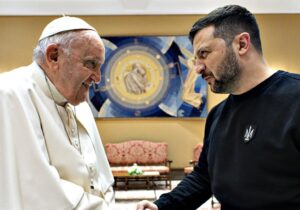
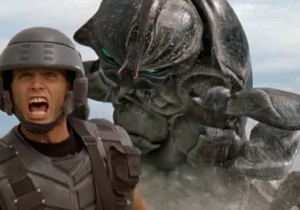
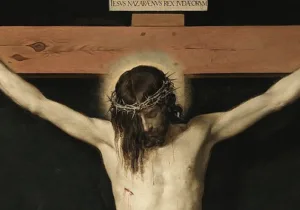

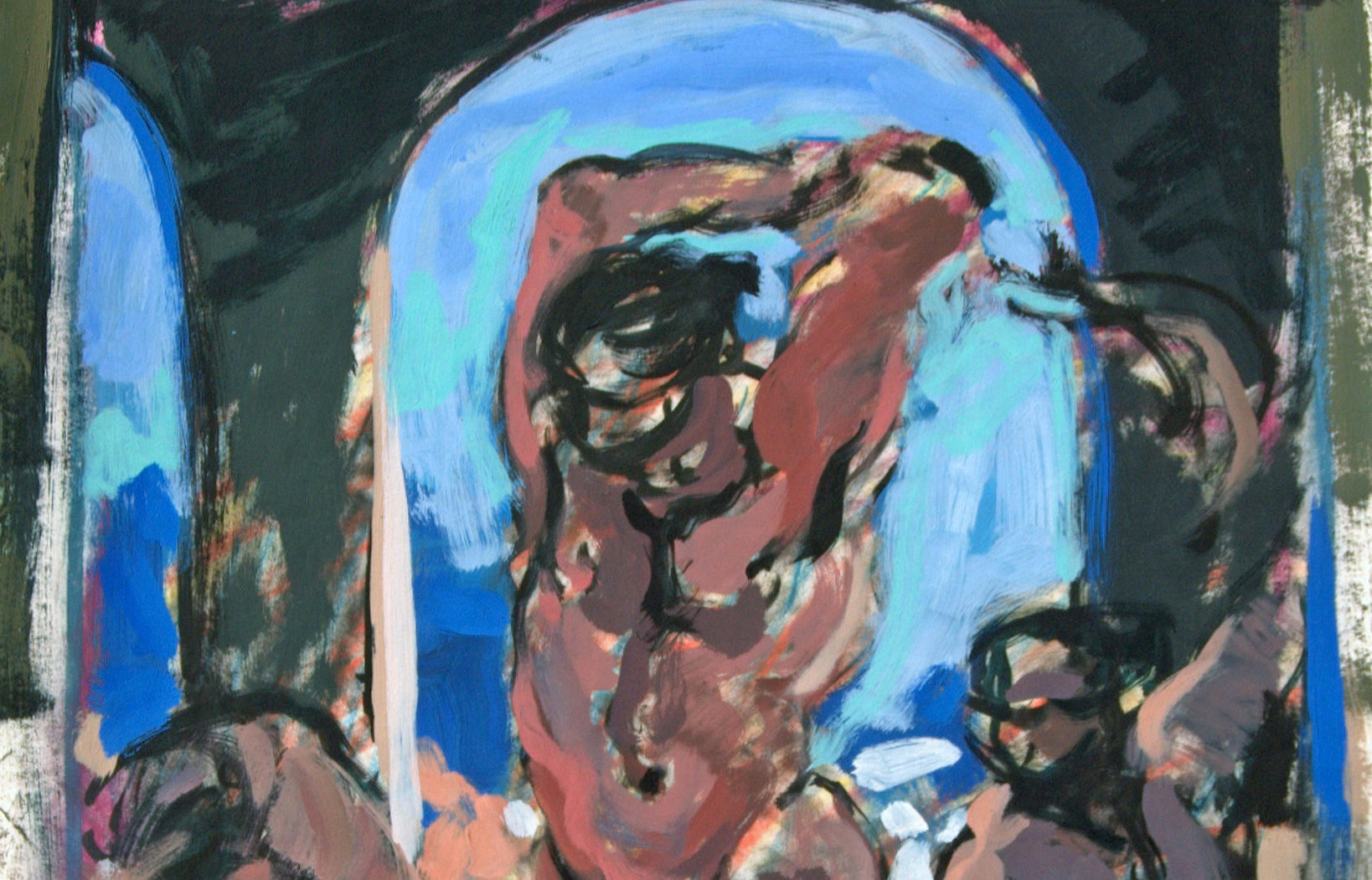

 Sponsor a student for Christianity & National Security 2024
Sponsor a student for Christianity & National Security 2024